#Maria Toledo
Explore tagged Tumblr posts
Video
youtube
Stan Getz · Luiz Bonfá · Maria Toledo - Saudade Vem Correndo
4 notes
·
View notes
Text
Sambalero, Stan Getz, Luiz Bonfá, Maria Toledo
0 notes
Text
"Santa Maria de Toledo Cathedral" Spain
The Cathedral of Saint Mary one of the three 13th century High Gothic cathedrals is Spain.
Construction began in 1226 under the rule of Ferdinand III and the last Gothic contributions were made in the 15th century when, in 1493, the vaults of the central nave were finished during the time of the Catholic Monarchs.
The structure of the building is greatly influenced by the French Gothic style of the 13th century but adapted to Spanish taste.
#light academia#dark academia#classical#academia aesthetic#escapism#academia#books and libraries#classic literature#books#architecture#place#destination#travel#vacation#tourisim#history#historical#building#video#interior#Santa Maria de Toledo Cathedral#spain#gothic#1200s#13th century#Ferdinand III#royal core#cottage core#aesthetic#academic
824 notes
·
View notes
Text

T O L E D O
55 notes
·
View notes
Text
youtube
#history#royal history#lindsay holiday#philippe I duke of orleans#queer#queer history#philippe de lorraine#henriette anna of england#louis xiv#armand de gramont#elizabeth charlotte of the palatinate#anne lennard#armand charles de la porte de la meilleraye#charles II#aphra behn#her history#henry of prussia#blainville#count la roche laymon#christian ludwig von kaphengst#frederick II#isabella of bourbon-parma#joseph II#maria christina of teschen#ludwig viktor of austria#luisa isabel alvarez de toledo#leoncio gonzalez de gregorio#liliana maria dahlmann#ivar mountbatten#mavendra singh gohil
2 notes
·
View notes
Text
Three tickets to Challengers, please

#could a depressed person make THIS? NO.#fernando alvarez de toledo#garcilaso de la vega#maria enriquez de toledo y guzman
1 note
·
View note
Text
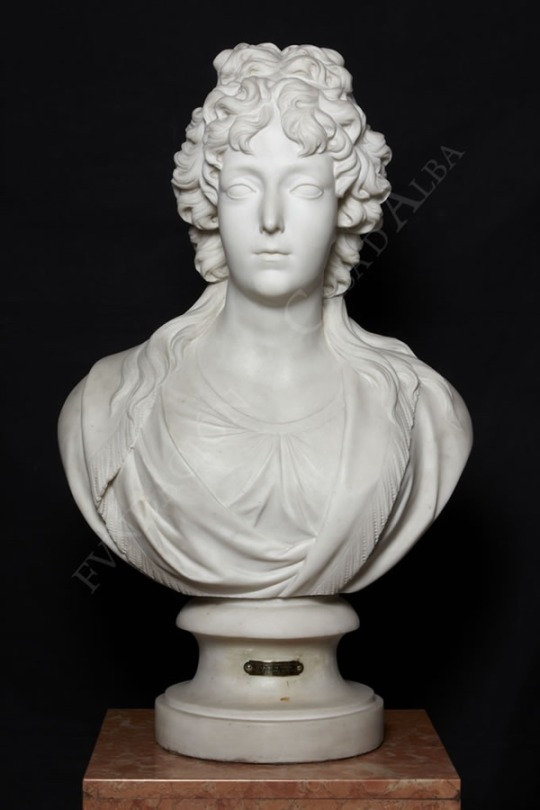
#duchess of alba#maria teresa de silva#bust#statue#xviiith century#18th century#Juan de Adán Morlando#María del Pilar Teresa Cayetana de Silva y Álvarez de Toledo
0 notes
Text
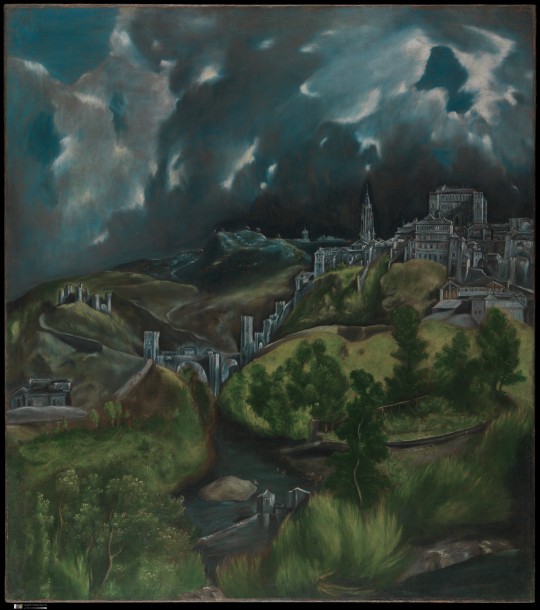
View of Toledo (1599-1600) 🎨 El Greco 🏛️ The Metropolitan Museum of Art 📍 New York City, United States
Writing to the sculptor Auguste Rodin after having been astonished by this painting in Paris in 1908, the poet Rainer Maria Rilke described how “splintered light tills the ground, turning it over, tearing into it and bringing up here and there pale green meadows behind the trees standing like insomniacs.” Regarded as El Greco’s greatest landscape, it portrays Toledo, the city where he lived and worked for most of his life. But it is an emotive rather than a documentary vision that not only imaginatively revises the skyline—most notably, the cathedral has been moved—but also distorts architecture and landscape such that they are fully in service of the kind of drama Rilke and other modernists appreciated in his work.
#View of Toledo#El Greco#landscape#painting#oil painting#oil on canvas#The Metropolitan Museum of Art#the met#1599#1600#art#artwork#art history#new york city#nyc
36 notes
·
View notes
Text

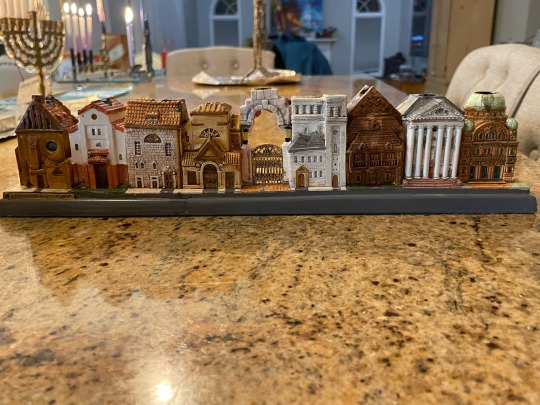
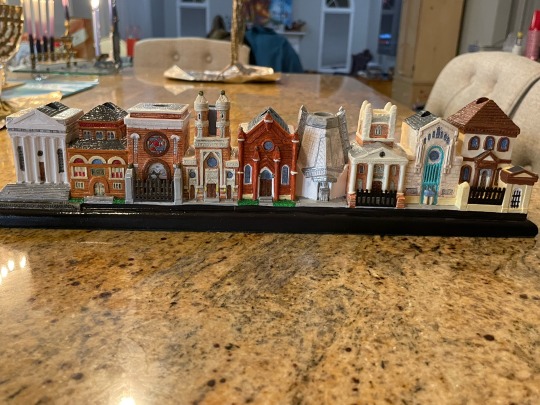
These are the three menorahs that we own that we did not light this year (but we did display them).
The first one is an artsy menorah that I'm pretty sure we got at the same time as our oil one. It is very much not my style and has never been. We've never used it, likely because my mom doesn't want to bother with having to clean out the wax from various places, which I get.
The second one is Synagogues of Europe by artist Maude Weisser. The plaque on it says it was made in 1995, but I'm not sure when/where we bought it. As you can see, it hasn't survived previous lightings very well, which is why we didn't light it or the next one.
The synagogues depicted are (from right to left):
Prague, Czechoslovakia: The Altneuschul or "Old-New Synagogue" (c.1280)
Toledo, Spain: Santa Maria La Blanca Synagogue (c. 1200)
Dubrovnik, Yugoslavia: The Dubrovnik Synagogue was built in the 17th century
Cracow, Poland: The Rema Synagogue (c. 1550)
Vilna, Poland: This gate is located at the entrance to the Shulhof on Jews' Street in the Jewish Quarter of Vila.
Lutsk, Poland: The Lutsh Fortress Synagogue (c. 1626)
Zabludow, Poland: The Zabludow Synagogue (c. 1756)
Budapest, Hungary: The Synagogue in Obuda (1820)
Florence, Italy: Tiempo Israelitico, completed (1882)
The third one is Synagogues of North America, also by artist Maude Weisser. This one has a little plaque that says it was designed in 1997, but we got it two summers ago at the Touro Synagogue (the synagogue on the far right), the first purpose-built synagogue in the United States, in Newport, Rhode Island, where the artist herself was working (!!!).
The synagogues depicted are (from right to left):
Newport, Rhode Island: Touro Synagogue (dedicated 1763)
New York City: Temple Emanu-El (built in 1929)
New York City: B'nai Jeshurun (consecrated in 1827)
Elkins Park, Pennsylvania: Beth Shalom (built in 1959; designed by Frank Lloyd Wright)
San Fransisco, California: Shearith Israel (built in 1854)
Cincinnati, Ohio: Congregation B'nai Jeshurun (built in 1848)
Boston, Massachusetts: The Vilna Shul (built in 1919)
Chicago, Illinois: Kehilat Anshei Ma'Arav (built in 1891)
Charleston, South Carolina: Beth Elohim (built in 1840)
Bonus: a shot of all our menorahs because seven nights’ worth of candles is too pretty not to share:
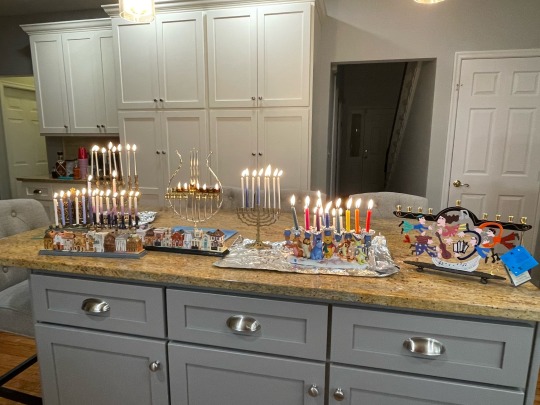
#Hanukkah#Chanukah#hanukkiah#menorah#my hanukkiot#synagogue#synagogues of europe#synagogues of north america#maude weisser#long post#my menorahs#chanukahproject
13 notes
·
View notes
Text

Floor tiles. Antigua Sinagoga Santa Maria la Blanc, Toledo. Abril ‘24🇪🇸
32 notes
·
View notes
Text













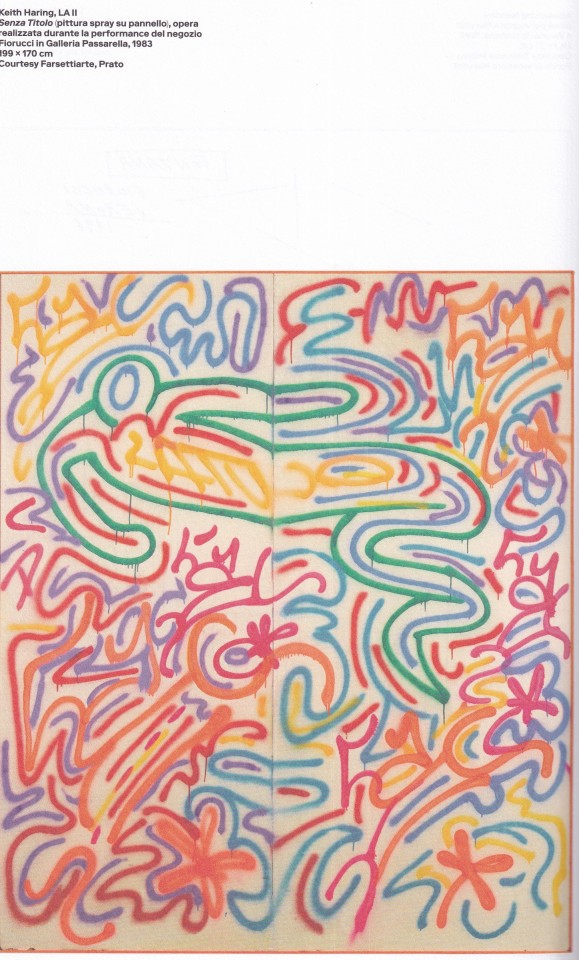






Elio Fiorucci
a cura di Judith Clark
Testi di Stefano Boeri, Monica Bolzoni, Fabio Cherstich, Augusta fiorucci, Ersilia Fiorucci, Floria Fiorucci, Maria Luisa Frisa, Gianmarco Gronchi, Barbara Hulanicki, Franco Marabelli, Giannino Malossi, Lucia Moschella, Marilia Pederbelli, Cristina Rossi, Marco Sanmichele, Ruben Toledo, Isabella Tonchi, Maurizio Turchet
Fashion archive AD visitor : Luca Stoppini
Triennale, Electa Milano 2024, 304 pagine,20x30cm, ISBN 978882826175
euro 50,00
email if you want to buy [email protected]
mostra Triennale Milano 6 novembre 2024 , 16 marzo 2025
Il volume, pubblicato in occasione dell’omonima mostra in Triennale , traccia le vicende umane, imprenditoriali e culturali di Elio Fiorucci attraverso saggi critici, testimonianze, interviste e un ricco apparato iconografico che presenta, oltre ad abiti e accessori, bozzetti, illustrazioni, grafica, documenti inediti e progetti di allestimento dei numerosi autori e creativi che hanno collaborato con lui.
Elio Fiorucci(Milano, 1935-2015) è stato l’origine, e uno dei principali magneti, della costellazione di idee radicali, irriverenti e rivoluzionarie che, a partire dalla seconda metà degli anni sessanta, hanno influenzato temi e linguaggi di generazioni di giovani di tutto il mondo. I suoi concept store, oltre a proporre per la prima volta al pubblico un mix eclettico di abbigliamento, dischi, libri, riviste e oggetti esotici, sono stati il punto di riferimento per happening e performance: palcoscenici capaci di attrarre intellettuali, performer, musicisti e artisti. Una visione articolata e complessa della moda intesa come manifestazione di processi connessi a trasformazioni sociali, politiche e culturali.

18/12/24
#Elio Fiorucci#Fiorucci#exhibition catalogue#Triennale Milano 2024#fashion books#fashionbooksmilano#Keith Haring
9 notes
·
View notes
Text
Fan Art . Inspired from Tin Star by Allen Gies.

~ Marshal Editon Maverick (MC) & Maria A. Toledo ~
"You must understand; there are troubles ahead," Maria explains, "of limitations and exclusions. Eduardo is a good bodyguard, but I chose him because he is discrete and utterly loyal to me. Carlos, my uncle, will not be so obliging. I can not be seen with you except as expectations demand. Rumors spread, you understand, and I will not dishonor my family by appearing imprudent."
5 notes
·
View notes
Text

Cathedral of Santa Maria in Toledo, SPAIN
31 notes
·
View notes
Text
Ages of Medici Women at First Marriage
I have only included women whose birth dates and dates of marriage are known within at least 1-2 years, therefore, this is not a comprehensive list.
This list is composed of Medici women from 1386 to 1691 CE; 38 women in total.
Piccarda Bueria, wife of Giovanni di Bicci de’ Medici: age 18 when she married Giovanni in 1386 CE
Contessina de’ Bardi, wife of Cosimo de’ Medici: age 25 when she married Cosimo in 1415 CE
Lucrezia Tornabuoni, wife of Piero di Cosimo de’ Medici: age 17 when she married Piero in 1444 CE
Bianca de’ Medici, daughter of Piero di Cosimo de’ Medici: age 14 when she married Guglielmo de’ Pazzi in 1459 CE
Lucrezia de’ Medici, daughter of Piero di Cosimo de’ Medici: age 13 when she married Bernardo Rucellai in 1461 CE
Clarice Orsini, wife of Lorenzo de’ Medici: age 16 when she married Lorenzo in 1469 CE
Caterina Sforza, wife of Giovanni de' Medici il Popolano: age 10 when she married Girolamo Riario in 1473 CE
Semiramide Appiano, wife of Lorenzo di Pierfrancesco de' Medici: age 18 when she married Lorenzo in 1482 C
Lucrezia de’ Medici, daughter of Lorenzo de’ Medici: age 18 when she married Jacopo Salviati in 1488 CE
Alfonsina Orsini, wife of Piero di Lorenzo de’ Medici: age 16 when she married Piero in 1488 CE
Maddalena de’ Medici, daughter of Lorenzo de’ Medici: age 15 when she married Franceschetto Cybo in 1488 CE
Contessina de’ Medici, daughter of Lorenzo de’ Medici: age 16 when she married Piero Ridolfi in 1494 CE
Clarice de’ Medici, daughter of Piero di Lorenzo de’ Medici: age 19 when she married Filippo Strozzi the Younger in 1508 CE
Filberta of Savoy, wife of Giuliano de’ Medici: age 17 when she married Giuliano in 1515 CE
Madeleine de La Tour d’Auvergne, wife of Lorenzo II de’ Medici: age 20 when she married Lorenzo in 1518 CE
Catherine de’ Medici, daughter of Lorenzo II de’ Medici: age 14 when she married Henry II of France in 1533 CE
Margaret of Parma, wife of Alessandro de’ Medici: age 13 when she married Alessandro in 1536 CE
Eleanor of Toledo, wife of Cosimo I de’ Medici: age 17 when she married Cosimo in 1539 CE
Giulia de’ Medici, daughter of Alessandro de’ Medici: age 15 when she married Francesco Cantelmo in 1550 CE
Isabella de’ Medici, daughter of Cosimo I de’ Medici: age 16 when she married Paolo Giordano I Orsini in 1558 CE
Lucrezia de’ Medici, daughter of Cosimo I de’ Medici: age 13 when she married Alfonso II d’Este in 1558 CE
Bianca Cappello, wife of Francesco I de’ Medici: age 15 when she married Pietro Bonaventuri in 1563 CE
Joanna of Austria, wife of Francesco I de’ Medici: age 18 when she married Francesco in 1565 CE
Camilla Martelli, wife of Cosimo I de’ Medici: age 25 when she married Cosimo in 1570 CE
Eleanor de’ Medici, daughter of Francesco I de’ Medici: age 17 when she married Vincenzo I Gonzaga in 1584 CE
Virginia de’ Medici, daughter of Cosimo I de’ Medici: age 18 when she married Cesare d’Este in 1586 CE
Christina of Lorraine, wife of Ferdinando I de’ Medici: age 24 when she married Ferdinando in 1589 CE
Marie de’ Medici, daughter of Francesco I de’ Medici: age 25 when she married Henry IV of France in 1600 CE
Maria Maddalena of Austria, wife of Cosimo II de’ Medici: age 19 when she married Cosimo in 1608 CE
Caterina de’ Medici, daughter of Ferdinando I de’ Medici: age 24 when she married Ferdinando Gonzago in 1617 CE
Claudia de’ Medici, daughter of Ferdinando I de’ Medici: age 16 when she married Federico Ubaldo della Rovere in 1620 CE
Margherita de’ Medici, daughter of Cosimo II de’ Medici: age 16 when she married Odoardo Farnese in 1628 CE
Vittoria della Rovere, wife of Ferdinando II de’ Medici: age 12 when she married Ferdinando in 1634 CE
Anna de’ Medici, daughter of Cosimo II de’ Medici: age 30 when she married Ferdinand Charles of Austria in 1646 CE
Marguerite Louise d’Orleans, wife of Cosimo III de’ Medici: age 16 when she married Cosimo in 1661 CE
Violante Beatrice of Bavaria, wife of Ferdinando de’ Medici: age 16 when she married Ferdinando in 1689 CE
Anna Maria Franziska of Saxe-Lauenberg, wife of Gian Gastone de’ Medici: age 18 when she married Philipp Wilhelm of Neuberg in 1690 CE
Anna Maria Luisa de’ Medici, daughter of Cosimo III de’ Medici: age 24 when she married Johann Wilhelm, Elector Palatine in 1691 CE
The average age at first marriage among these women was 17 years old.
17 notes
·
View notes
Text
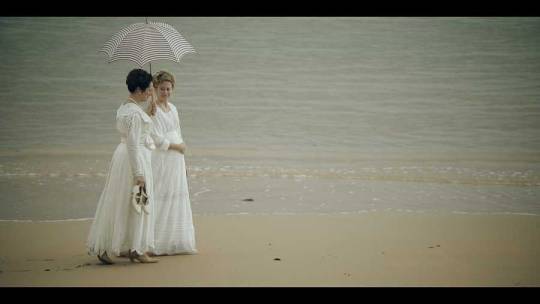
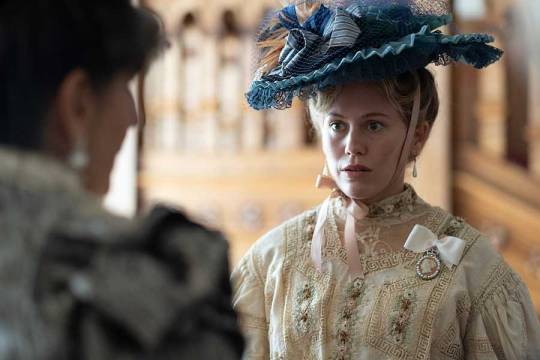






Upcoming series: Ena
In September, the filming of Ena began, a biographical series that will focus on the life of Victoria Eugenie of Battenberg, queen of Spain through her marriage to Alfonso XIII between May 31, 1906 and April 14, 1931, after being the monarchy deposed later by the proclamation of the Second Republic. Great-grandmother of the current king Philip VI of Spain, of whom she was godmother at his baptism. Throughout six chapters, the series will tell the life of Victoria Eugenie and at the same time offer a portrait of a time that changed the world, the first half of the 20th century, from 1905 to 1945. Born on October 24, 1887 in Aberdeenshire, Scotland, Ena was the daughter of Henry of Battenberg and Princess Beatrice, youngest daughter of Queen Victoria of the United Kingdom and Prince Albert of Saxe-Coburg and Gotha. Her godmother was Eugenia de Montijo, empress consort of France as Napoleón III's wife. The name of the series comes from what her friends and family called her since she was little, Ena.
The fiction is based on the novel of the same name by Pilar Eyre. Javier Olivares, who was behind the acclaimed Isabel and El Ministerio del Tiempo, will be the showrunner and plot manager for Ena. In addition to Olivares, the script is written by Isa Sánchez, Daniel Corpas and Pablo Lara Toledo. The series will be directed entirely by women: Anaïs Pareto, director of the series as a whole, in addition to four episodes, and Estel Díaz, who will direct two episodes.
“Ena is the portrait of historical moments that seem distant but are not so far away, because without them we would not understand the times we live in now,” Olivares declares in the press release sent by TVE. The writer and screenwriter remembers that Victoria Eugenie “fought to be happy in a bitter time, in which she witnessed two world wars, a civil war and a great pandemic, the tortuously called Spanish flu.”
For Pilar Eyre, author of the novel, she was "an extraordinary woman: cultured, supportive, liberal-minded, modern and very loyal." And she is excited because "finally all Spaniards can know" the story of a "misunderstood" woman. in their time, which they will always consider foreign." It is a fiction co-produced by RTVE with Ena La Serie AIE, La Cometa TV and Zona App. José Pastor, director of Film and Fiction at RTVE, has pointed out that "it is a "RTVE is proud to be able to portray this interesting historical character, from the point of view of two women directors and with Javier Olivares as showrunner, in one of its best series."
The Spanish actress of Anglo-Danish descent Kimberly Tell will play Ena and Joan Amargós will play Alfonso XIII. For her part, Elvira Mínguez will play Maria Christina von Habsburg-Lothringen, mother of Alfonso XIII. The cast is completed by Lucía Guerrero (Beatrice of Saxe-Coburg and Gotha), Raúl Mérida (Alfonso of Orleans and Bourbon), Juan Gea (Álvaro Figueroa y Torres, Count of Romanones), María Morales (María del Carmen Angoloti y Mesa, Duchess of Victoria), Pedro Mari Sánchez (Rodrigo de Saavedra y Vinent, Marquis of Villalobar), Luisa Gavasa (Eugenia de Montijo) and Joaquín Notario (José de Saavedra y Salamanca, Marquis of Viana)
Mariano Peña will play Miguel Primo de Rivera; Jaume Madaula will play the anarchist Mateo Morral, author of the attack committed at the royal wedding; Tomás del Estal will be Emilio María de Torres y González-Arnáu, and Ángel Ruiz will once again give life to Federico García Lorca, a character he already played in El Ministerio del Tiempo, among others.
The series will be filmed entirely in natural exteriors and interiors, like the Royal Palace of Madrid, the Palace of La Granja de San Ildefonso (Segovia), the Palace of Santoña (Madrid), the Palace of Fernán Núñez (Madrid), the Fort of San Francisco (Guadalajara) and the Magdalena Palace (Santander), built in 1911 by the City Council as a tribute to the monarchs and where Ena spent a good part of her summers in Spain, accompanied by the Royal Family. Filming for the series will continue until the end of December.
~~~~~~~~~~~~~~~~~~~~~~~~~~~~~~~~~~~~~~~~~~
So, the Magdalena Palace is going to be an important location during the series as a summer palace, the main filming location in Gran Hotel, and in that series Ena appeared in the episode 3×13, played by Aída Filx.
Apart from that, are we getting an Olivaresverse (XD)? Most likely not, and it's just references about his previous works as a showrunner, but there are connections between Isabel, Emdt and Ena: Michelle Jenner starring Isabel as Isabella I of Castile, then appearing in a couple of scenes in Emdt episode 1×04 and being an important figure in the lore as the foundress of the ministry (& Eusebio Poncela playing as Cisneros in both series, and also he played Cisneros in the film La Corona Partida and the Carlos Rey Emperador series); Alfonso XIII is a descendant of Isabella I of Castile; Ángel Ruiz appeard as Lorca in Emdt in 4 episodes and now he is on Ena playing as Lorca again, we don't know yet how much screentime he will get or which will his role be (secondary character most likely), but it's great to see more about him!
#Ena#period dramas#upcoming series#ena tve#victoria eugenie of battenberg#maria christina von hasburg#alfonso xiii of spain#kimberley tell#joan amargós#rtve series#pilar eyre#javier olivares#anaïs pareto#estel diaz#federico garcía lorca#ángel ruiz#elvira míngez#maria christina von hasburg-lothringen#lucía guerrero#beatrice of saxe-coburg and gotha#raúl mérida#alfonso of orleans and bourbon#juan gea#álvaro figueroa y torres#maría morales#maría del carmen angoloti y mesa#pedro mari sánchez#rodrigo de saavedra y vinent#luisa gavasa#eugenia de montijo
21 notes
·
View notes
Text
Agnolo Bronzino - Maria (di Cosimo I) de' Medici, 1551

(English / Español / Italiano)
Maria de Cosimo de' Medici, also known as Maria Lucrezia, was born on 3 April 1540 in Livorno, Italy. She was the eldest daughter of the 2nd Duke of Florence, Cosimo I de' Medici, and his wife, Leonor Alvarez de Toledo. Maria was the first of eleven legitimate children of the marriage.
From birth, Maria was brought up as a true princess. She lived with her parents in the Palazzo Vecchio, where she received a thorough education. Among his tutors were Pierfrancesco Riccio and Antonio Angeli da Barga, and he is said to have been fluent in Spanish, taught by his mother and various teachers.
At an early age, her marriage to Alfonso II of Este was planned. However, the marriage never took place because Maria contracted malaria and died on 19 November 1557 in Livorno, aged 17. Her death was a devastating blow to her family.
A beautiful portrait by Agnolo Bronzino remains of Maria when she was about eight years old. This portrait is preserved in the Uffizi Gallery and is one of the most solemn, emphasising the dark colours of the costume and the background.
Her remains are buried in the oratory of the Fortezza di Livorno. Despite her short life, Maria is remembered as an important figure in the history of the Medici family and her portrait remains a masterpiece of Renaissance art.
Maria de Cosimo de' Medici is a tragic figure whose life and death left an indelible mark on her family and on Florentine culture. Her story is a reminder of the fragility of life and the importance of family in Renaissance society.
-----------------------------------------------------------------------------
María de Cosme de Médici, también conocida como María Lucrecia, nació el 3 de abril de 1540 en Livorno, Italia. Era la hija mayor del II Duque de Florencia, Cosme I de Médici, y su esposa, Leonor Álvarez de Toledo. María fue la primera de once hijos legítimos del matrimonio.
Desde su nacimiento, María fue educada como una verdadera princesa. Vivió con sus padres en el Palazzo Vecchio, donde recibió una educación esmerada. Entre sus tutores estaban Pierfrancesco Riccio y Antonio Angeli da Barga, y se dice que hablaba con fluidez el español, enseñado por su madre y diferentes profesores.
A una temprana edad, se planeó su matrimonio con Alfonso II de Este. Sin embargo, el matrimonio nunca se concretó debido a que María contrajo malaria y falleció el 19 de noviembre de 1557 en Livorno, a los 17 años. Su muerte fue un golpe devastador para su familia.
De María queda un precioso retrato realizado por Agnolo Bronzino cuando tenía alrededor de ocho años. Este retrato se conserva en la Galería de los Uffizi y es uno de los más solemnes, destacando los colores oscuros del traje y el fondo.
Sus restos están sepultados en el oratorio de la Fortezza di Livorno. A pesar de su corta vida, María es recordada como una figura importante en la historia de la familia Médici y su retrato sigue siendo una obra maestra del arte renacentista.
María de Cosme de Médici es una figura trágica cuya vida y muerte dejaron una marca indeleble en su familia y en la cultura florentina. Su historia es un recordatorio de la fragilidad de la vida y la importancia de la familia en la sociedad renacentista.
------------------------------------------------------------------------------
Maria de Cosimo de' Medici, nota anche come Maria Lucrezia, nacque il 3 aprile 1540 a Livorno. Era la figlia maggiore del II Duca di Firenze, Cosimo I de' Medici, e di sua moglie, Leonor Alvarez de Toledo. Maria fu la prima degli undici figli legittimi del matrimonio.
Fin dalla nascita, Maria fu educata come una vera principessa. Visse con i genitori a Palazzo Vecchio, dove ricevette un'educazione accurata. Tra i suoi precettori c'erano Pierfrancesco Riccio e Antonio Angeli da Barga, e si dice che conoscesse bene lo spagnolo, insegnato dalla madre e da vari maestri.
In giovane età fu progettato il suo matrimonio con Alfonso II d'Este. Tuttavia, il matrimonio non ebbe mai luogo perché Maria contrasse la malaria e morì il 19 novembre 1557 a Livorno, all'età di 17 anni. La sua morte fu un colpo devastante per la sua famiglia.
Di Agnolo Bronzino resta un bellissimo ritratto di Maria all'età di circa otto anni. Questo ritratto, conservato nella Galleria degli Uffizi, è uno dei più solenni e mette in risalto i colori scuri del costume e dello sfondo.
Le sue spoglie sono sepolte nell'oratorio della Fortezza di Livorno. Nonostante la sua breve vita, Maria è ricordata come una figura importante nella storia della famiglia Medici e il suo ritratto rimane un capolavoro dell'arte rinascimentale.
Maria di Cosimo de' Medici è una figura tragica, la cui vita e morte hanno lasciato un segno indelebile nella sua famiglia e nella cultura fiorentina. La sua storia ci ricorda la fragilità della vita e l'importanza della famiglia nella società rinascimentale.
Source: Historia AI
#renacimiento#renaissance#rinascimento#painting#pittura#16th century#s XVI#cosimo de medici#leonor alvarez de toledo#il bronzino#agnolo bronzino
2 notes
·
View notes